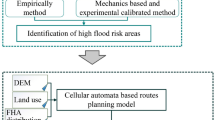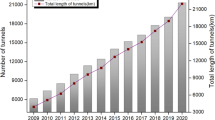Abstract
The objective of this study is to propose a new method to evaluate the performance of different evacuation modes, and to find a rational evacuation mode for long underwater vehicle tunnels. In this study, a combined evacuation model (TPES) incorporating both a traffic flow module and a crowd evacuation module is proposed to simulate the integrated crowd evacuation with the effects of traffic flow, and the model is partially validated by a field evacuation test and a verified model Simulex. A vehicle tunnel was modeled to simulate fire-related traffic congestion and passenger evacuation, and then the evacuation performance index Im of three evacuation modes in different fire situations were calculated. The results revealed that the hybrid evacuation mode performs best among the three modes, with Im superior to other two modes by up to 26%. The transversal evacuation passage mode performs better than the longitudinal mode under the same conditions. However, the transversal and longitudinal modes can be equivalent when the passage spacing difference is within a range of 150–200 m. The critical spacing of the evacuation passage in a simple evacuation process lies in between 100 m and 350 m at confidence level of 90% for the transversal evacuation mode.
















Similar content being viewed by others
References
Zhao JW, Peng FL, Wang TQ, Zhang XY, Jiang BN (2016) Advances in master planning of urban underground space (UUS) in China. Tunn Undergr Space Technol 55:290–307
Peng J, Peng FL (2018) A GIS-based evaluation method of underground space resources for urban spatial planning: part 1 methodology. Tunn Undergr Space Technol 74:82–95
Peng J, Peng FL (2018) A GIS-based evaluation method of underground space resources for urban spatial planning: part 2 application. Tunn Undergr Space Technol 77:142–165
Yao C-P (2008) Risk-based design research of escape channels in Shanghai Yangtze River Tunnel. Doctoral dissertation, Tongji University, Shanghai
Shanghai Construction and Communications Commission (2008) Road Tunnel Design Code. 2008-07-01
Yamada N, Ota Y (1999) Safety systems for the Trans-Tokyo Bay Highway tunnel project. Tunn Undergr Space Technol 14(1):3–12
Gwynne S, Galea ER, Owen M, Lawrence PJ, Filippidis L (1999) A review of the methodologies used in evacuation modelling. Fire Mater 23(6):383–388
Yang GS, Peng LM, Zhang JH, An YL (2006) Simulation of people’s evacuation in tunnel fire. J Cent South Univ Technol 13(3):307–312
Ronchi E, Colonna P, Capote J, Alvear D, Berloco N, Cuesta A (2012) The evaluation of different evacuation models for assessing road tunnel safety analysis. Tunn Undergr Space Technol 30:74–84
Caliendo C, Ciambelli P, De Guglielmo ML, Meo MG, Russo P (2012) Simulation of people evacuation in the event of a road tunnel fire. Proc Soc Behav Sci 53:178–188
Valasek L, Glasa J (2013) Simulation of the course of evacuation in tunnel fire conditions by FDS + Evac. In: Proceedings of the 2013 international conference on applied mathematics and computational methods in engineering, pp 288–295
Boer LC (2002). Behaviour by motorists on evacuation of a tunnel. Rapport TNO Human Factors
Norén A, Winér J (2003) Modelling crowd evacuation from road and train tunnels-data and design for faster evacuations. LUTVDG/TVBB–5127–SE
Zhang Y-C, Xiang Y, He C, et al (2016) Experimental study on pedestrian behavior and traffic capacity of cross passage in highway tunnel. J Southwest Jiaotiong Univ 4:615–620
Papageorgiou M, Schmidt G (1984) Freeway traffic modelling and control. In: Control in transportation systems, pp 195–202
Yu L, Shi Z K (2007) Density waves in traffic flow model with relative velocity. Eur Phys J B 57(1):115–120
Canter D, Breaux J, Sime J (1980) Domestic, multiple occupancy and hospital fires. In: Canter D (ed) Fires and Human Behaviour, chap 8. John Wiley & Sons, New York, pp 117–136
Sime JD (1985) Movement toward the familiar: person and place affiliation in a fire entrapment setting. Environ Behav 17(6):697–724
Nilsson D, Johansson A (2009) Social influence during the initial phase of a fire evacuation—analysis of evacuation experiments in a cinema theatre. Fire Saf J 44(1):71–79
Fridolf K, Nilsson D, Frantzich H (2013) Fire evacuation in underground transportation systems: a review of accidents and empirical research. Fire Technol 49(2):451–475
Gehandler J (2015) Road tunnel fire safety and risk: a review. Fire Sci Rev 4(1):2
Burstedde C, Klauck K, Schadschneider A, & Zittartz J (2001) Simulation of pedestrian dynamics using a two-dimensional cellular automaton. Phys A Stat Mech Appl 295(3):507–525
Varas A, Cornejo MD, Mainemer D, Toledo B, Rogan J, Munoz V, Valdivia JA (2007) Cellular automaton model for evacuation process with obstacles. Phys A Stat Mech Appl 382(2):631–642
Ezaki T, Yanagisawa D, Ohtsuka K, Nishinari K (2012) Simulation of space acquisition process of pedestrians using proxemic floor field model. Phys A Stat Mech Appl 391(1):291–299
Wolfram S (2002) A new kind of science, vol 5. Wolfram Media, Champaign
Nagel K, Schreckenberg M (1992) A cellular automaton model for freeway traffic. J Phys I 2(12):2221–2229
Nagel K, Paczuski M (1995) Emergent traffic jams. Phys Rev E 51(4): 2909
Takayasu M, Takayasu H (1993) 1/f noise in a traffic model. Fractals 1(04):860–866
Benjamin SC, Johnson NF, Hui PM (1996) Cellular automata models of traffic flow along a highway containing a junction. J Phys A Math Gen 29(12):3119
Helbing D, Molnar P (1995) Social force model for pedestrian dynamics. Phys Rev E 51(5):4282
Helbing D, Molnar P (1998) Self-organization phenomena in pedestrian crowds. arXiv preprint arXiv:cond-mat/9806152
Helbing D, Johansson A (2009) Pedestrian, crowd and evacuation dynamics. In: Meyers RA (ed) Encyclopedia of complexity and systems science. Springer, New York, pp 6476–6495
Kuligowski ED, Peacock RD, Hoskins BL (2005) A review of building evacuation models. US Department of Commerce, National Institute of Standards and Technology, Gaithersburg
Ronchi E, Kuligowski ED, Reneke PA, Peacock RD, Nilsson D (2013) The process of verification and validation of building fire evacuation models. US Department of Commerce, National Institute of Standards and Technology, Gaithersburg
Guide, S. U. 6.0 (2012) Integrated environmental solutions limited
Li W-P, Xu Y, Liao S-M (2012) Discussion and modification of RSET calculation method in road tunnel fire. China Saf Sci J 22(9):43–50
Xiang Y, Cao Y-L, Chen S-M, et al (2015) Research on the equivalent spacing for horizontal and vertical evacuation channel of underwater road tunnel. In: Proceedings of the 2015 international symposium on fire engineering technology. Science and Technology Information Bureau of Ministry of Public Security
Cao Y-L (2016) Research on experiment for vertical evacuation of underwater highway tunnel with large cross-section. Master’s thesis, Southwest Jiao Tong University
Zhang X, Xu Z-S, Ni T-X, et al (2011) Research on evacuation mode of underwater highway tunnel during fire. In: Proceedings of 2011 annual meeting of science and technology of China Fire Protection Association
Xu Y, Liao S-M, Li W-P, et al (2012) Risk assessment on escape distance in road tunnel fire. China Civ Eng J 45(12):155–161
Acknowledgements
The financial support from the National Basic Research Program Project (No. 2015CB057806) and Research Projects (Nos. 16DZ1200202, 17DZ1203804) from Shanghai Committee of Science and Technology are gratefully appreciated.
Author information
Authors and Affiliations
Corresponding author
Additional information
Publisher's Note
Springer Nature remains neutral with regard to jurisdictional claims in published maps and institutional affiliations.
Rights and permissions
About this article
Cite this article
Xu, Y., Liao, S. & Liu, M. Simulation and Assessment of Fire Evacuation Modes for Long Underwater Vehicle Tunnels. Fire Technol 55, 729–754 (2019). https://doi.org/10.1007/s10694-018-0798-8
Received:
Accepted:
Published:
Issue Date:
DOI: https://doi.org/10.1007/s10694-018-0798-8




